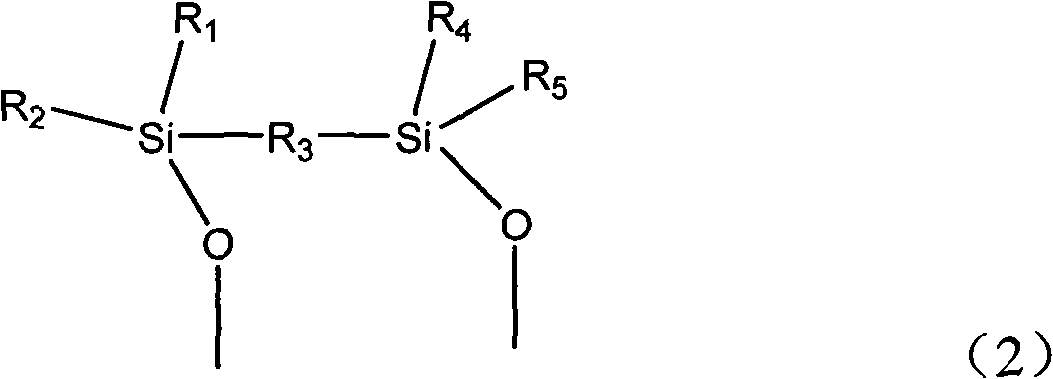Catalytic conversion method of ketone and alcohol
The technology of a catalyst and a hydrogenation catalyst is applied in the field of hydrogenation of ketones to prepare alcohols and dehydrogenation of alcohols to ketones, and achieves the effects of small surface area carbon generation, long service life and reduced side reactions
- Summary
- Abstract
- Description
- Claims
- Application Information
AI Technical Summary
Problems solved by technology
Method used
Image
Examples
Embodiment 1
[0058] Get the clover shape Ni-Zn-K / diatomite catalyst 50 grams of diameter 3mm (volume 72ml, the mass percentage content of Ni, Cr, Mo and K is respectively 28%, 12% and 3.5%, the balance is diatomite ), the catalyst is loaded into a fixed bed reactor (diameter 25mm, length 1000mm, with six temperature display control points). After the reactor temperature is stabilized at 80°C, the hydrogen containing 3vol% methyltriethoxysilane is passed into the reactor, the flow rate is controlled at 300ml / min, and the temperature is raised to 120°C after maintaining 80°C for 2 hours. Keep for 1 hour to stop the hydrogen gas containing methyltriethoxysilane, add nitrogen to lower the temperature, and obtain catalyst Cat-1.
[0059] Compare Ni-Zn-K / diatomaceous earth and Cat-1 by Fourier transform infrared spectrometer (FTIR), the characteristic peak of the methyl group on Cat-1 (~2970cm -1 ) is obviously stronger than Ni-Zn-K / diatomite, and the characteristic peak of hydroxyl group (~375...
Embodiment 2
[0063] Take a strip Cu-Cr-Ba / Al with a diameter of 3mm 2 o 3 -SiO 2 Catalyst 15 grams (produced by Beijing Research Institute of Chemical Industry, volume 24ml, the mass percentage content of Cu, Cr and Ba is respectively 28%, 12% and 2%, the balance is Al 2 o 3 -SiO 2 ), the catalyst is packed in a 500ml three-necked bottle, and the three-necked bottle is placed in an oil bath. One of the three-necked bottles is connected to a cooling coil, one is connected to a thermometer, and the other is connected to a feed inlet. First, 80ml of p-xylene was poured into the three-neck flask, and after the temperature of the reactor was stabilized at 110°C, 8ml of hexamethylsilazane was passed into the reactor. After maintaining 110°C for 1 hour, the temperature was raised to 140°C. After the temperature was stabilized, the temperature was maintained for 1 hour and then lowered. The catalyst was taken out and dried in an oven at 160°C for 3 hours to obtain catalyst Cat-3.
[0064] Com...
Embodiment 3
[0068] The catalysts of Example 1 and Comparative Example 1 were respectively applied to gas-phase hydrogenation of acetone to isopropanol. The hydrogenation reactor is a 100ml isothermal fixed bed, and the catalyst is 10.0g. The technological conditions of hydrogenation reaction are as table 1 (selectivity refers to isopropanol selectivity). After 800 h of reaction, the amount of carbon deposition was compared by thermogravimetry-mass spectrometry.
[0069] The reaction conditions are shown in Table 1, wherein the molar ratio of hydrogen to acetone is 8.0. The results are shown in Table 1. The experiment shows that compared with the existing method, the method of the present invention has high target selectivity, low carbon content on the surface area of the catalyst, and low deactivation rate.
[0070] Table 1 Catalyst catalytic reaction performance of embodiment 1 and comparative example 1
[0071]
[0072] Determination of carbon deposition: Thermogravimetry-mass s...
PUM
 Login to View More
Login to View More Abstract
Description
Claims
Application Information
 Login to View More
Login to View More - R&D
- Intellectual Property
- Life Sciences
- Materials
- Tech Scout
- Unparalleled Data Quality
- Higher Quality Content
- 60% Fewer Hallucinations
Browse by: Latest US Patents, China's latest patents, Technical Efficacy Thesaurus, Application Domain, Technology Topic, Popular Technical Reports.
© 2025 PatSnap. All rights reserved.Legal|Privacy policy|Modern Slavery Act Transparency Statement|Sitemap|About US| Contact US: help@patsnap.com



